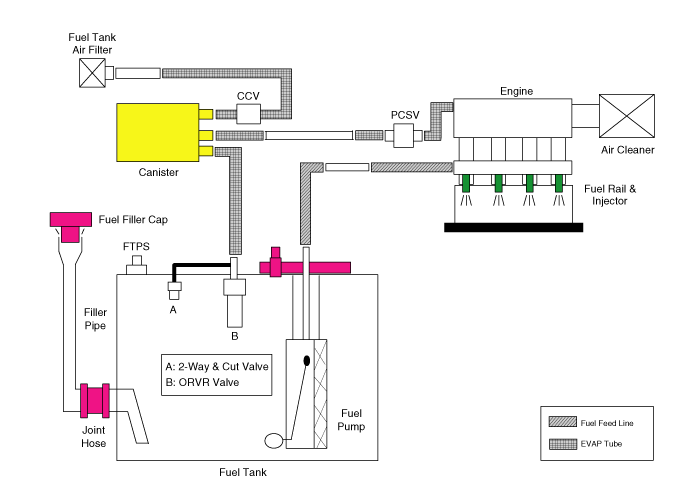Hyundai Tucson: Evaporative Emission Control System / Schematic Diagrams
Hyundai Tucson (LM) 2010-2015 Service Manual / Emission Control System / Evaporative Emission Control System / Schematic Diagrams
| Schematic Diagram |

Canister
The Canister is filled with charcoal and absorbs evaporated
fuel vapor from the fuel tank. The gathered fuel vapor in canister is
drawn into the intake manifold by the ECM/PCM when appropriate
conditions are set.
Purge Control Solenoid Valve (PCSV)
The Purge Control Solenoid Valve (PCSV) is installed in the
passage connecting the canister to the intake manifold. It is a duty
type solenoid valve and is operated by ECM/PCM signal.
To draw the absorbed vapor into the intake manifold, the ECM/PCM will open the PCSV, otherwise the passage remains closed.
Fuel Filler Cap
A ratchet tightening device in the threaded fuel filler cap
reduces the chances of incorrect installation, when sealing the fuel
filler. After the gasket on the fuel filler cap and the fill neck flange
make contact, the ratchet produces a loud clicking noise indicating the
seal has been set.
Fuel Tank Pressure Sensor (FTPS)
The Fuel Tank Pressure Sensor (FTPS) is an integral part of
the monitoring system. The FTPS checks Purge Control Solenoid Valve
(PCSV) operation and leaks in the Evaporative Emission Control System by
monitoring pressure and vacuum level in the fuel tank during PCSV
operating cycles.
Canister Close Valve (CCV)
The Canister Close Valve (CCV) is located between the
canister and the fuel tank air filter. It closes off the air inlet to
the canister for the Evaporative Emissions System and also prevents fuel
vapors from escaping from the Canister when the vehicle is not
operating.
Evaporative System Monitoring
The Evaporative Emission Control Monitoring System monitors
fuel vapor generation, evacuation, and a leakage check step. At first,
the OBD-II system checks if vapor generation due to fuel temperature is
small enough to start monitoring. Then it evacuates the evaporative
system by means of PCSV with ramp in order to maintain a certain vacuum
level. The final step is to check if there is vacuum loss by any leakage
of the system.
Vapor Generation Checking
During the stabilization period, the PCSV and the CCV are
closed. The system pressure is measured as starting pressure (DP_A).
After a certain defined period (T1), the system pressure (DP_B) is
measured again and the difference from the starting pressure is
calculated. If this difference (DP_B - DP_A) is bigger than the
threshold, there should be excessive vapor pressure and the monitor is
aborted for next check. On the contrary, if the difference is lower than
the negative threshold, the PCSV is regarded as having a malfunction
such as clogged at open position.
Large EVAP Leak Detection
The PCSV is opened with a certain ramp for the pressure to
reach down to a certain level. If the pressure can’t be lowered below a
threshold, the system is regarded as having a fuel cap-open or having a
large leak.
Leaking Checking
The PCSV is closed and the system waits for a period to get
stabilized pressure. During checking period (T2), the system measures
the beginning and the end of the system pressure (DP_C, DP_D). The
diagnosis value is the pressure difference corrected by the natural
vapor generation (DP_B - DP_A) rate from the vapor generation check
step.
 Description and Operation
Description and Operation
Description
The Evaporative Emission Control System prevents fuel vapor
stored in fuel tank from vaporizing into the atmosphere. When the fuel
evaporates in the fuel tank, the vapor passes thro ...
 Components and Components Location
Components and Components Location
Components Location
1. Purge Control Solenoid Valve (PCSV)2. Vapor line3. ORVR valve4. Fuel tank air filter5. Canister Close Valve (CCV)6. Canister7. Fuel Tank Pressure Sensor (FTPS)
...
Other information:
Hyundai Tucson (LM) 2010-2015 Owners Manual: Emergency towing
If towing is necessary, we recommend you have it done by an authorized HYUNDAI
dealer or a commercial tow truck service.
If towing service is not available in an emergency, your vehicle may be temporarily
towed using a cable or chain secured to the emergency towing hook at the front (or
rea ...
Hyundai Tucson (LM) 2010-2015 Service Manual: Engine Coolant Temperature Sensor (ECTS) Specifications
Specification
TemperatureResistance (kx)°C°F-40-4048.14-20-414.13 ~ 16.830325.7920682.31 ~ 2.59401041.15601400.59801760.32
...
© 2010-2024 www.htmanual.net
